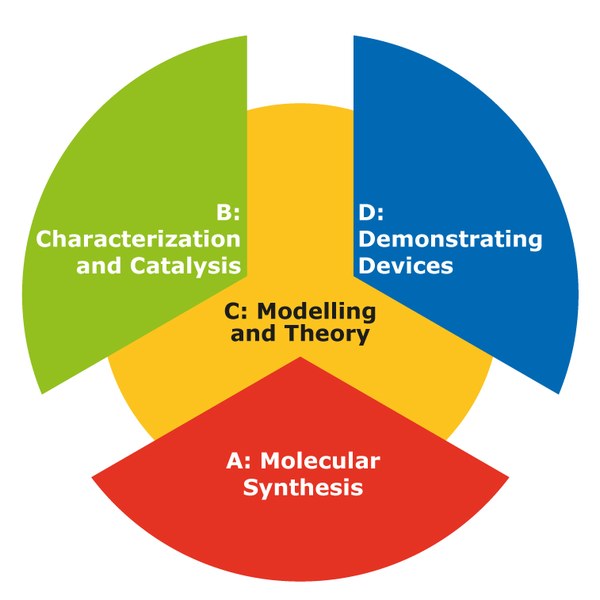Research Units

Research units
The design of MOST systems poses great challenges to synthetic, analytical, and applied chemistry. A multidisciplinary approach is indispensable which combines the expertise to develop new MOST switches (synthesis), to explore their functionality (spectroscopy), to model their properties (theory) and to test them in demonstrating devices. FOR MOST brings together the required expertise to form a spear-heading research team in Germany, which along with leading international researchers world-wide, pushes the emerging field of MOST to the next level.

We define the term mostophore as the molecular entity, which can be converted from a low energy structure to a meta-stable isomer upon absorption of solar irradiation and then release the stored energy on demand.
Part A - Molecular Synthesis
A-Azo. New strategies to increase storage densities, storage duration, and solar spectrum match will be explored using the family of AB switches. Optimization strategies include the smart combination of multiple photochromic compounds, the utilization of molecular interactions (e.g. London dispersion), supramolecular arrangements (e.g. π-stacking) or bond-forming reactions. In this part, also flow systems will be investigated to study the storage and release processes as well as for synthesis to allow accessing large amounts of material. A-BN. Fundamental understanding of the energy storage and energy release steps of the BNB switches will be gained by investigation of carefully designed BNB/BND couples. The studies will target high storage energy density, extended storage times, and match with the solar spectrum. The synthesis of BNB systems will be streamlined using flow systems to allow accessing large amounts of material. A-Nor. The goal of this project is to synthesize and optimize new NBD/QC based photoswitches in order to generate efficient MOST concepts. A library of new push-pull functionalized NBD/QC couples will be generated and investigated. Through combination of the NBD scaffold with chromophores (e.g. perylene diimide), fully photo-switchable MOST candidates will be synthesized. Nanoparticle-based and confined space systems will be investigated in terms of water solubility and catalysis. By using magnetic nanoparticles, full cycle Energy harvest/storage/release devices will be developed. |
PIsA-Azo: Tuning storage in MOST systems using intra- and intermolecular interactions with azobenzenes A-BN: Boron-Nitrogen containing heterocycles for MOST application A-Nor: New Concepts for the Norbornadiene/Quadricyclane (NBD/QC) Interconversion |
Part B - Characterization and Catalysis
B-Cat. This project aims at the development of new catalysts, synthetic methods, and the understanding of the underlying processes to push Forward the discovery of new MOST systems. The focus will be on the development of efficient catalysts for the macroscopic energy release with a primary focus on BNB systems. The studies will include catalyst development, immobilization, and mechanistic investigations. In addition, new catalytic Methods will be developed for the functionalization of mostophores for modular modification of their properties. B-Surf. This project targets the efficient and controllable energy release in MOST systems at the solid/liquid interface. Combining state-of-the-art in-situ spectroscopies and microscopies in surface science and photo(electro)chemistry, we will explore the mechanisms and elementary kinetics of catalytically and electrochemically triggered energy release. Our studies shall provide the fundamental understanding required to develop operation concepts for practical MOST technologies. B-Spec. State-of-the-art time-resolved optical spectroscopic techniques will be employed to study the primary photochemistry of novel, rationally designed NBD-, BN- and AB-based mostophores. These studies will provide a molecular understanding of the role of different substituents on thermal energy storage efficiency. In multichromophore compounds, we will address how inter-and intramolecular interactions influence the photo- and thermal conversion. We will develop illumination protocols for optimized thermal energy release. |
PIsB-Surf: Triggering the energy release from MOST compounds at interfaces B-Spec: Molecular mechanisms of energy storage and release in MOST systems B-Cat: Catalytic processes for the efficient energy release from MOST compounds |
Part C - Modelling and Theory
Computational Chemsitry will be an integral part of FOR MOST during the design phase, but also to rationalize the experimental results from Part A & B. They will provide increasingly accurate theoretical models, which will guide the design of the next generation of mostophores as well as experiments to further probe and improve the current understanding of the Underlying MOST principles. C-Ground. This theoretical project will focus on understanding and optimizing the structureproperty relationships and catalytic processes that trigger the energy release of MOST systems. To this aim, we will develop stepwise screening approaches to study single molecules by first-principles calculations and machine learning tools. We will also investigate catalytic and surfacedriven ground state processes to gain insight into the reaction mechanisms, energy landscapes, and side reactions. Furthermore, we will shed light on the role of intermolecular non-covalent interactions in solution and in molecular crystals to optimize parameters important for MOST systems. C-Photo. Self-developed and existing state-of-the-art quantum chemical methods and datadriven machine learning approaches will be used to computationally optimize and predict novel mostophores, guide synthesis efforts, and assist spectroscopic investigations. In addition, new concepts and strategies to increase Energy storage, lifetimes, and overlap with the solar spectrum will be computationally investigated based on the inclusion of additional stabilizing interactions of the high-energy storage state. Finally, we will study the electrochemically triggered energy release by means of theoretical methods. |
PIsC-Ground: Computational modelling of catalytic processes and screening of MOST compounds C-Photo: Computational photochemistry and design of MOST systems |
Part D - Demonstrating Devices
A selection of the most promising molecular systems will be tested in devices for use in device applications. The solar-driven storage and heat release experiments will be used to assess performance parameters needed to understand the possible future application of the MOST systems. Information exchange with the group working on the molecular design and function (Part A/B/C) ensures a rapid feedback loop of learning and improving the systems. D-Dev. This project will target the investigation of MOST systems for and in device applications. |
PID-Dev: Exploring MOST for/in Devices Network Partner |










